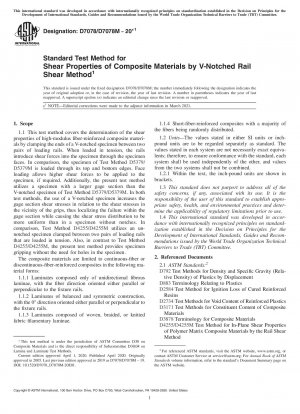ASTM D7078/D7078M-20e1
Standard Test Method for Shear Properties of Composite Materials by V-Notched Rail Shear Method
- Standard No.
- ASTM D7078/D7078M-20e1
- Release Date
- 2020
- Published By
- American Society for Testing and Materials (ASTM)
- Latest
- ASTM D7078/D7078M-20e1
- Scope
- 1.1 This test method covers the determination of the shear properties of high-modulus fiber-reinforced composite materials by clamping the ends of a V-notched specimen between two pairs of loading rails. When loaded in tension, the rails introduce shear forces into the specimen through the specimen faces. In comparison, the specimen of Test Method D5379/ D5379M is loaded through its top and bottom edges. Face loading allows higher shear forces to be applied to the specimen, if required. Additionally, the present test method utilizes a specimen with a larger gage section than the V-notched specimen of Test Method D5379/D5379M. In both test methods, the use of a V-notched specimen increases the gage section shear stresses in relation to the shear stresses in the vicinity of the grips, thus localizing the failure within the gage section while causing the shear stress distribution to be more uniform than in a specimen without notches. In comparison, Test Method D4255/D4255M utilizes an unnotched specimen clamped between two pairs of loading rails that are loaded in tension. Also, in contrast to Test Method D4255/D4255M, the present test method provides specimen gripping without the need for holes in the specimen. The composite materials are limited to continuous-fiber or discontinuous-fiber-reinforced composites in the following material forms: 1.1.1 Laminates composed only of unidirectional fibrous laminae, with the fiber direction oriented either parallel or perpendicular to the fixture rails. 1.1.2 Laminates of balanced and symmetric construction, with the 0° direction oriented either parallel or perpendicular to the fixture rails. 1.1.3 Laminates composed of woven, braided, or knitted fabric filamentary laminae. 1.1.4 Short-fiber-reinforced composites with a majority of the fibers being randomly distributed. 1.2 Units—The values stated in either SI units or inchpound units are to be regarded separately as standard. The values stated in each system are not necessarily exact equivalents; therefore, to ensure conformance with the standard, each system shall be used independently of the other, and values from the two systems shall not be combined. 1.2.1 Within the text, the inch-pound units are shown in brackets. 1.3 This standard does not purport to address all of the safety concerns, if any, associated with its use. It is the responsibility of the user of this standard to establish appropriate safety, health, and environmental practices and determine the applicability of regulatory limitations prior to use. 1.4 This international standard was developed in accordance with internationally recognized principles on standardization established in the Decision on Principles for the Development of International Standards, Guides and Recommendations issued by the World Trade Organization Technical Barriers to Trade (TBT) Committee.
ASTM D7078/D7078M-20e1 Referenced Document
- ASTM D2584 Standard Test Method for Ignition Loss of Cured Reinforced Resins
- ASTM D2734 Standard Test Methods for Void Content of Reinforced Plastics
- ASTM D3171 Standard Test Methods for Constituent Content of Composite Materials
- ASTM D3878 Standard Terminology Composite Materials
- ASTM D4255/D4255M Standard Test Method for In-Plane Shear Properties of Polymer Matrix Composite Materials by the Rail Shear Method
- ASTM D5229/D5229M Standard Test Method for Moisture Absorption Properties and Equilibrium Conditioning of Polymer Matrix Composite Materials
- ASTM D5379/D5379M Standard Test Method for Shear Properties of Composite Materials by the V-Notched Beam Method
- ASTM D6856 Standard Guide for Testing Fabric-Reinforced "Textile" Composite Materials*, 2024-04-20 Update
- ASTM D792 Standard Test Methods for Density and Specific Gravity (Relative Density) of Plastics by Displacement
- ASTM D883 Standard Terminology Relating to Plastics*, 2024-02-01 Update
- ASTM E111 Standard Test Method for Young''s Modulus, Tangent Modulus, and Chord Modulus
- ASTM E122 Standard Practice for Calculating Sample Size to Estimate, With a Specified Tolerable Error, the Average for Characteristic of a Lot or Process
- ASTM E1237 Standard Guide for Installing Bonded Resistance Strain Gages
- ASTM E1309 Standard Guide for Identification of Fiber-Reinforced Polymer-Matrix Composite Materials in Databases*, 2024-04-20 Update
- ASTM E1434 Standard Guide for Recording Mechanical Test Data of Fiber-Reinforced Composite Materials in Databases*, 2024-04-20 Update
- ASTM E177 Standard Practice for Use of the Terms Precision and Bias in ASTM Test Methods
- ASTM E251 Standard Test Methods for Performance Characteristics of Metallic Bonded Resistance Strain Gages
- ASTM E4 Standard Practices for Force Verification of Testing Machines
- ASTM E456 Standard Terminology for Relating to Quality and Statistics
- ASTM E6 Standard Terminology Relating to Methods of Mechanical Testing
ASTM D7078/D7078M-20e1 history
- 2020 ASTM D7078/D7078M-20e1 Standard Test Method for Shear Properties of Composite Materials by V-Notched Rail Shear Method
- 2020 ASTM D7078/D7078M-20 Standard Test Method for Shear Properties of Composite Materials by V-Notched Rail Shear Method
- 2019 ASTM D7078/D7078M-19 Standard Test Method for Shear Properties of Composite Materials by V-Notched Rail Shear Method
- 2012 ASTM D7078/D7078M-12 Standard Test Method for Shear Properties of Composite Materials by V-Notched Rail Shear Method
- 2005 ASTM D7078/D7078M-05 Standard Test Method for Shear Properties of Composite Materials by V-Notched Rail Shear Method
